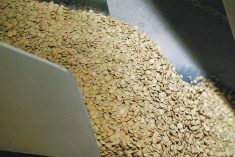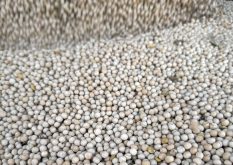We are into harvest in North America and so it is not unusual for crop prices to weaken as deliveries from the combine increase.
The question is: are these the seasonal lows and will prices firm into autumn, or could prices fall?
There are no issues I see that will force changes to the current market psychology so I’d be surprised to see shocking price movements up or down.
There might be small adjustments to production estimates for Northern Hemisphere crops but nothing earth shattering.
Read Also

Huge Black Sea flax crop to provide stiff competition
Russia and Kazakhstan harvested huge flax crops and will be providing stiff competition in China and the EU.
Winter wheat growing in the Southern Hemisphere might be trimmed further but the price support from that is offset by expectations of strong exports from Russia.
Of course, Black Sea grain exports are a wildcard. Russia scuttled the Black Sea export agreement and keeps bombing the remaining export outlets for Ukraine grain. Insurance from major companies for Russian grain export ships is drying up, however I expect that won’t seriously dent Russian exports.
The soybean and corn crops in South America are not yet seeded, but the market expects large production increases as El Nino takes hold and delivers improved moisture to Argentina and southern Brazil.
The biggest chance for a significant move in grain prices would be triggered if the El Nino does not play out as expected.
Let’s drill into the details.
In Western Canada, crop estimates are in flux with Saskatchewan Agriculture’s numbers diverging from Statistics Canada. Sask.Ag’s yield number for spring wheat in the province is substantially higher than Statistics Canada, but the province’s numbers for canola and durum are lower.
In the United States, the hot, dry weather of late August and early September in the Midwest likely trimmed yields, but we don’t yet know the magnitude of the damage.
The U.S. Department of Agriculture provided more detail in its monthly report Sept. 12, which was released after this column was produced.
Northeastern China, where most corn and soybeans are grown, had excessive rain in August from typhoons. There is speculation from foreign crop watchers about potential crop damage but the official government comments don’t show a major production decline.
Also, the U.S. Department of Agriculture attaché for China issued an oilseed outlook last week. It said Chinese soybean production was likely not severely hurt by the rain. Given that corn and soybeans tend to grow in the same area, that implies that the much bigger corn crop in China’s northeast might have dodged the bullet, but the situation remains murky.
However, if there really is significant damage, China’s crop imports could increase.
Most of Brazil’s 2022-23 corn has been harvested, and it has a record-breaking crop of around 132-135 million tonnes.
The already harvested 2022-23 soybean crop in Brazil is pegged at a massive 154.6 million tonnes.
Farmers in the central province of Mato Grosso have started planting 2023-24 soybeans. Normally, the government sets the seeding start at Sept. 16 to lessen the risk of soybean rust disease arriving early. But the date was moved up on the request of cotton growers who want more time to seed following the soy harvest.
Conab hasn’t forecasted 2023-24 production yet but the USDA has an early outlook of 163 million tonnes of soybeans, up 4.5 percent from 2022-23 and 129 million tonnes of corn, down 4.4 percent.
In Argentina, dry weather is trimming the yield prospects of the winter wheat crop now growing. The Buenos Aires grains exchange estimates a wheat harvest of 16.5 million tonnes. That is up from last year’s crop, which was hit hard by drought, but less than the early forecast for 18 million.
Expectations are that El Nino will soon end the drought in Argentina and southern Brazil.
The Buenos Aires exchange forecasts Argentina’s crops seeded this fall will be huge, with 50 million tonnes of soybeans, up from 21 million from 2022-23 and 55 million tonnes of corn, up from 34 million.
Australia’s winter crop weather has been dry and warm and the dryness could increase as El Nino’s grip tightens.
So far, the wheat production decline from the initial forecast in June is not that bad.
Australian government forecaster ABARES on Sept. 5 estimated the wheat crop at 25.4 million tonnes, down from the June forecast of 26.2 million tonnes and down 36 percent from last year .
Barley was pegged at 10.5 million tonnes, up from 9.9 million in June but down 26 percent from last year.
Canola is seen at 5.2 million tonnes, up from 4.9 million in June but down 38 percent from last year.
India’s monsoon is weak and its summer pulse crop will likely suffer, raising the strong potential for increased imports of Canadian pulses, particularly lentils.
If the monsoon continues weak, it could also harm the winter crop, including wheat and peas. The Indian government is already concerned about its wheat reserves and there is speculation it might import wheat, probably from Russia.

















